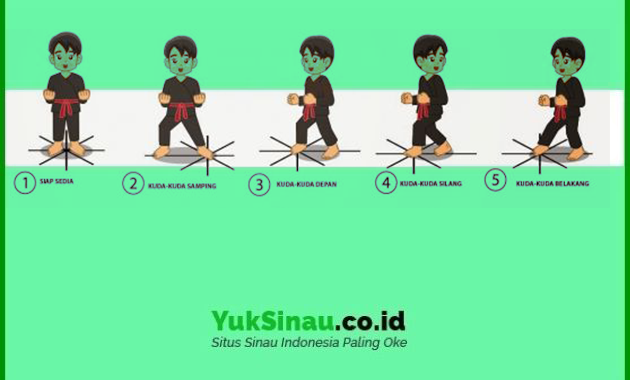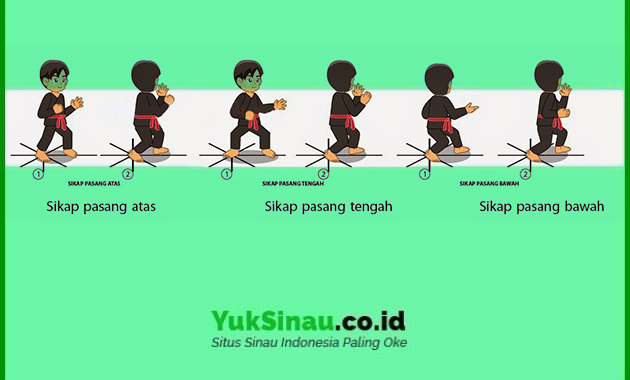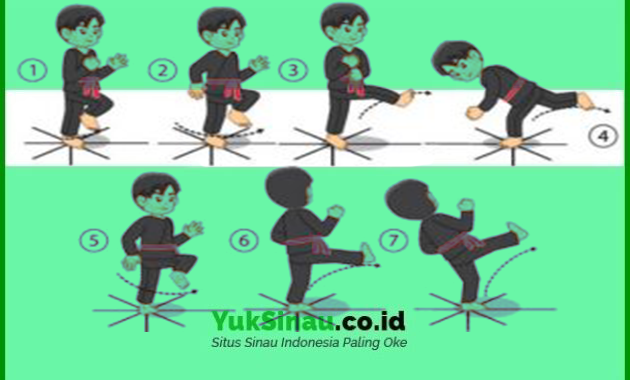Basic Pencak Silat Techniques
Basic Pencak Silat Techniques – At this time, yuksinau.co.id will explain the material about Pencak Silat which the discussion includes the meaning of, how to play, the rules, basic technique, examples of field images and news about sports in full.
Pencak Silat, martial arts that are considered unique, is a legacy of martial arts in Indonesia. There is a lot of history associated with Pencak silat in Indonesia. Many heroes in Indonesia even mastered martial arts techniques. Learning Pencak Silat can help you protect yourself and the environment around you.
Basic Techniques of Pencak Silat
The basics of Pencak Silat can be carefully studied in practice. Below this, The basic technique of pencak silat is broken down into several stages:
Horse Technique – Horses in Pencak Silat

The earliest basic Pencak Silat technique is the horse, the position of the Pencak Silat fighter. Horse position is a standing position to prepare to face the enemy. The pencak silat horse is divided into three parts, that is straddle menga, high standing, 6 horse position. The following is an explanation for the stance of the martial arts horse:
- Front posture
The forward posture position is to bring the position of one leg forward and then bend the back leg straight. The soles of the hind legs come out to the sides and the weight is stacked forward. Posture must be upright and straight.
- back posture
The position of the back posture is to put pressure on the back leg. Stack your heels to stand up so that your body leans forward. The forefoot is injured by placing the heel or toe on the floor.
- Medium horse
The position of the middle position is to spread both legs and bend them so that the body goes deeper. This position will build the load in the middle of the body.
- Horse Page
The side posture position is to bend one leg to the side and the other leg straight to the other side. Weight is placed on the bent leg, the body must be straight so that the shoulders are parallel or in line with the feet.
- Cross horse
The position of the cross stance is like a horse that combines the front and side horses. The front cross is formed by placing one leg forward and bending it. These feet carry the burden. The other foot is lightly pressed against the previous foot with the thumb or other fingertip pressed against the floor.
- Cross horse back
The position of the rear crossing horse is like the opposite of the rear crossing horse. As previously, the position of one leg is heavy support and the other is light. The difference is the position of the body backwards and the position of the legs of the light forward.
Posture in Silat
The basic techniques of Pencak Silat basically consist of postures (position) and movement (movement). When a fighter moves, her posture and movements change according to her previous movements and situations. Flood is a position that is ready to continue the next step. There is 5 types of couples by type, that is:
Squat Posture
It is a posture performed by placing the wrong foot on the floor. Squatting posture is divided into two areas:
- Squat Posture: Posture with straight posture, straight, with the legs bent at both ends of the inside of the feet with the heels raised.
- Gecko Posture: Posture to posture with straight posture, straight angle and legs forward with knees bent and feet with knees stacked on the floor.
Sitting Posture
It is a posture in which both feet are placed on the floor and the weight is above the waist. The sitting position is divided into four areas:
- Sitting posture: Stand up, look straight up and hold your ass on the floor. Position both feet and knees with knees facing forward and both arms bent at your body.
- Precepty attitude: Posture with upright posture, look straight ahead and cover the buttocks with the floor. The position of the feet in front of the body and the palms crossed above the knees.
- crouched posture: adopt an upright posture and look straight ahead. Legs folded back, with the toes fixed and the heel up. Palms placed on thighs.
- Posture of Sempok: Set the posture with a straight posture, with a straight look. The position of both legs is folded under the buttocks and the other leg is bent up. The position of the palms are in front of the chest and pointing upwards.
Lying Posture
An attitude is taken to defend oneself. The reclining posture consists of three, that is:
- Lying posture: posture on the body position on the back, looking forward, bend one leg and one leg straight. One hand is placed on the floor with the elbow bent and the other on the chest.
- Leaning posture: take a leaning posture, look ahead, one leg to the chest and the other straight ahead. The position of the hand supports the weight by placing the elbow on the floor and the other hand on the thigh.
- Flatbed Attitude: Take a body position facing down. Look forward and spread both legs. The position of both hands touching the floor by bending the elbows towards the meeting.
Special Attitude
Is an attitude used to practice balance in defense and attack. Custom settings are divided into five types, that is:
- The special setting is upright once
- Build an upright posture, foresight. Lift one leg with the knee bent and facing forward and the arm out to the side with the fist and elbow bent.
- Lower pancreas special posture
- Take the body position with the supine position, looking ahead. The position of the knee is bent and the sole of the foot is closed to the floor while the other leg is lifted. The position of both hands is next to the body with curved elbows.
- Pancer Special Attitude lay back
- Take the body position with the supine position, looking ahead. One knee bent position, press the sole of the foot to the floor and lift the other leg. The position of both hands is next to the body with curved elbows.
- Rimau Special Attitude (crawl)
- Standing on all fours. Position both legs bent, one forward and another backward.
- Monkey's special attitude
- Form a posture with a straight posture and a straight view. The position of the legs is tilted and both hands bend the elbows in front of the chest.
Attitude attach
It is an attitude that is ready to take action against a motivated attack. This arrangement is made at the beginning or end of the activity. Consists of 4 level, the following explanation:
- Install one: Stand straight with both hands by your side in a straight and ready position. Place your feet shoulder width apart.
- The second couple: adopt a straight posture, the position of the feet shoulder width apart and the position of the hands beside the waist with fists dengan.
- Install three: adopt an upright posture and open shoulder width apart. The position of the hands is bent up so that the palms are in line with the position of the eyes.
- Install four: Take an upright position and open it shoulder width apart. The position of the arms in front of the chest and the fists are crossed.
3 direction
Is the target direction of the target movement in Pencak Silat, both in defense and in attack. The direction in which the wind point is used as the direction. His direction is often done in martial arts training. One aspect that can be trained with direction is the movement of the horse.
In practice, side horses are used for the first to fourth sets. Put your left foot forward and your right back, in straight position. Movement from fifth to eighth position right foot in front and left foot behind. The position of the left leg is extended and the right leg is bent, body position is tilted slightly forward and vice versa
Step Pattern in Pencak Silat

Step is the basic technique of pencak silat and the walking method used in pencak silat. The following explanations apply to some step patterns:
- Straight step pattern: move in a pattern that forms a straight line forward or backward. Shown with horse, usually medium horse.
- Pola zig-zag: move with patterns that form zig-zag lines. Start the steps with an oblique step / tilted.
- Step horse pattern or letter U: move your feet to the right, cover with left foot, cover with left foot, close with right foot forward and do the opposite. The movement creates a pattern like the letter U.
- Triangle step pattern: move in a pattern that forms a triangle. Exhibited with 2 kuda, i.e. middle and front horse
- Step pattern S: moving with unification 3 horses that form the letter S. The horses used include the middle horse, side and back.
- Rectangular step pattern: move with the fusion of the middle and front horse. This is done by completing the front horse and then moving forward, with the center horse forming the last rectangle.
- Kuda, The attitude and pattern of steps in Pencak Silat are often one of the elements of traditional dances in Indonesia.
- Blow Pencak Silat
The offensive moves in Pencak Silat are divided into two parts, namely punches and kicks. Strike is an attacking movement that uses the hands as a tool. Several types of stamps in Pencak Silat are generally used:
Straight shot: Straight punch or front punch is done by pushing the hand straight forward, by moving the body forward when hitting. There are two straight lines, one seam and one straight. Shock leg position parallel to the arm, while the position of the straight leg is not parallel to the arm.
Punch the pendulum: Often referred to as coke blow, bottom-up punch with a slight bend.
Upright shot: A hit on the opponent's shoulder becomes the target
Circular Strike: The attack is made from the side of the fighter's body moving towards the fighter. This support is supported by body and shoulder movement to achieve a deeper effect.
Enter pencak silat
Regardless of the attack, attack move is kick. A kick is a movement you use to hit an opponent with your foot as a tool. Here are some explanations for Pencak Silat Kicks:
- Straight Kick: The kick moves straight and goes to the opponent's stomach.
- Circular kick: kick movement from the outside and then swinging to a straight leg.
- T-shaped kick: Pedaling movement from body position to the side and straight pedaling movement.
- Side kick: Kick with the back foot.
Blocks in Pencak Silat
Defending or defending is a move other than attacking. Movement in Pencak Silat uses hands and feet as tools. The following explanation:
- Internal objections: Prevent external attacks by keeping your hands in line with your shoulders.
- outdoor fence: Defend against outside attacks with your hands to ward off attacks from your opponent to the side.
- On: Parry an outside attack targeting the head by placing your hands above your head.
- Bottom row: Protect yourself from outside attacks that reach your lower body by lowering your body and stretching your arms down.
Other Moves
There are movements in Pencak Silat besides defending and attacking. Generally, movement with a blow, kicks and fights done. The following moves are moves other than those mentioned. The following explanation:
Neckline
This technique is designed to overthrow the opponent. Sweeping or chopping is a technique that makes the opponent fall by shaking the horse. The trick is to sweep, nailing, or cut off the enemy's legs until the enemy loses balance and falls. Cutout movement consists of outer cutout and inner cutout.
Lockdown
Is a movement to bring down a helpless opponent, not move or disarm the enemy's war equipment. Lockout is evasion, deception and fast movement. The lock generally targets the wrist, arm, neck, chin, or the shoulders of the enemy.
flower
It is a hand movement and posture that is done while paying attention to the enemy's movement and the enemy's defense. Generally, development moves are done at the beginning of the fight to anticipate attacks or outwit the enemy. Kembangan is one of the most important parts of the evaluation which prioritizes the beauty of movement in Pencak art.
This is how this discussion is about Basic Pencak Silat Techniques. And Don't Forget to Keep Visiting yuksinau.co.id because many articles are interesting and useful. Thank you for being loyal with us and still sinau all my friends.
Also Read Other Interesting Articles :
- Table Tennis Basics
- Badminton Basic Techniques
- Volleyball Basic Techniques
- Basketball Basic Techniques
- The Basic Technique of Sepak Takraw
- Basic Football Techniques
The post Teknik Dasar Pencak Silat appeared first on YukSinau.co.id.
